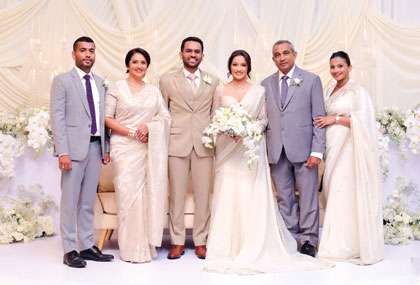“Esala Mangallya” Dalada Perahera
{{hitsCtrl.values.hits}}
8 July 2014 11:16 am
IT’S PAGEANTRY TIME OF THE YEAR, AND KANDY IS ALIVE WITH THE
 Kandy town is like a comely lass, awaiting her bridal finery and the magical day of the wedding. Come the perahera season, the normally busy town center of Kandy becomes active like the proverbial bee-hive. Like bees to the flower, people from all around the country as well as from around the world, flock to Kandy. During this time of the year, it becomes extremely difficult to find lodging in Kandy due to the hordes of tourists - local and international - visiting Kandy to view the most elaborate of the processions ever to walk the roads of this ancient citadel . It is none other than what you and I know as the “Dalada Perahera” or the “Nuwara Perahera”. In this life time, one must experience the exhilaration of the perahera at least once in their lifetimes, if not more !!
The month of July is named “Esala” in the local traditional calendar and it is a busy time for all the temples in the country. It is during this month that temples hold their annual perahera festivities in great fashion. Of all the temples in the country, the Temple of the Sacred Tooth Relic is extra special and revered for the reason that it is the principal place of worship for the Buddhists , where the sacred tooth relic of the Lord Buddha is housed. Each ruler who ever ruled the island made it their life’s mission to safeguard the sacred tooth relic as it symbolises the right of reign for the heir to the throne. Even after the end of the rule of kings, every ruler thereafter made it their responsibility to make sure that proper worship and reverence is accorded to the sacred tooth relic. Hence, the annual perahera of the Temple of the Sacred Tooth Relic was held with full governmental sponsorship and due pageantry second to none.
Kandy, where the Temple of the Tooth Relic resides in the Dalada Maligawa, comes alive during this period, with hundreds flocking to the city to venerate the Tooth Relic as well as to enjoy the many festivities and processions. In the run-up to the main perahera day, the city becomes festooned with many decorations, and everybody in and around the main city of Kandy becomes fired with the excitement of the perahera. Both the pilgrim and the mere visitor to Kandy vie hard to be part of this historical, and glorious pageant of music, dance and drums to the accompaniment of old-fashioned illuminations provided by burning copra in wire baskets.
Esala perahera is thought to date back to 3rd Century BC when it was only a ritual performed to request the gods for proper rainfall for cultivation. After the Sacred Tooth Relic was brought to Sri Lanka by Prince Dantha and Princess Hemamala from India, and housed in a specially erected pavillion in Anuradhapura, every king who reigned in the country made it their responsibility to take care of the Sacred Tooth Relic. The perahera now performed has it’s roots in the period of King Kithsiri Meghawanna who ruled Anuradhapura in the 303-331 AD , when he decreed that it should be taken around the city for people to venerate and view. When the Kandyan Kingdom fell to the British, the custody of the Tooth Relic was handed over to the Maha Sangha and a lay custodian - the Diyawadana Nilame - who was appointed to assist in the routine administrative work. The sacred Tooth Relic also , over time, became the palladium of Sri Lanka, preservation of which depended on the country’s security and the true ruler became identified by the custody of the Tooth Relic.
In the run-up to the start of the festivities, the town is cleared of all it’s dirt and dust. Foot as well as vehicular traffic to and from the city is quite streamlined to make sure no conjestion takes place. The current one-way traffic system and the stringent rules applied to road-crossing by pedestrians seems to have worked wonders to clear the city’s congestion dramatically.
Following the new moon in the month of July, on an auspicious time and a date chosen especially for this task, an Esala , Jak or Rukattana tree is cut and this “Kap” is placed in the forecourt of each dewale, as a wow that the perahera be held. For five consecutive nights from then on, the dewale processions are conducted around the Kap, with drums, torches and flags. On the sixth night starts the Kumbal Perahera and for the first time, the perahera ventures out of the premises of the dewales and this is joined by the Maligawa Perahera as well.Each night, the perahera would now get added with other interesting items, becoming more elaborate and longer.After five days of Kumbal Perahera, the Randoli perahera would start. Randoli means palanquins of the queens. According to reports, during the earlier days, these palanquins were carried alongside the caparisoned elephants , but once the Maligawa perahera joined , King Kirthi Sri Rajasinghe had decreed that the palanquins be carried at the end of the perahera. It is believed that the presence of the palanquins in the perahera symbolises the presence of the consorts of the deities or the reigning monarch’s queens. Interestingly, there were different types of palanquins in use those days, and these were named differently according to the status of the person who used it.
Kandy town is like a comely lass, awaiting her bridal finery and the magical day of the wedding. Come the perahera season, the normally busy town center of Kandy becomes active like the proverbial bee-hive. Like bees to the flower, people from all around the country as well as from around the world, flock to Kandy. During this time of the year, it becomes extremely difficult to find lodging in Kandy due to the hordes of tourists - local and international - visiting Kandy to view the most elaborate of the processions ever to walk the roads of this ancient citadel . It is none other than what you and I know as the “Dalada Perahera” or the “Nuwara Perahera”. In this life time, one must experience the exhilaration of the perahera at least once in their lifetimes, if not more !!
The month of July is named “Esala” in the local traditional calendar and it is a busy time for all the temples in the country. It is during this month that temples hold their annual perahera festivities in great fashion. Of all the temples in the country, the Temple of the Sacred Tooth Relic is extra special and revered for the reason that it is the principal place of worship for the Buddhists , where the sacred tooth relic of the Lord Buddha is housed. Each ruler who ever ruled the island made it their life’s mission to safeguard the sacred tooth relic as it symbolises the right of reign for the heir to the throne. Even after the end of the rule of kings, every ruler thereafter made it their responsibility to make sure that proper worship and reverence is accorded to the sacred tooth relic. Hence, the annual perahera of the Temple of the Sacred Tooth Relic was held with full governmental sponsorship and due pageantry second to none.
Kandy, where the Temple of the Tooth Relic resides in the Dalada Maligawa, comes alive during this period, with hundreds flocking to the city to venerate the Tooth Relic as well as to enjoy the many festivities and processions. In the run-up to the main perahera day, the city becomes festooned with many decorations, and everybody in and around the main city of Kandy becomes fired with the excitement of the perahera. Both the pilgrim and the mere visitor to Kandy vie hard to be part of this historical, and glorious pageant of music, dance and drums to the accompaniment of old-fashioned illuminations provided by burning copra in wire baskets.
Esala perahera is thought to date back to 3rd Century BC when it was only a ritual performed to request the gods for proper rainfall for cultivation. After the Sacred Tooth Relic was brought to Sri Lanka by Prince Dantha and Princess Hemamala from India, and housed in a specially erected pavillion in Anuradhapura, every king who reigned in the country made it their responsibility to take care of the Sacred Tooth Relic. The perahera now performed has it’s roots in the period of King Kithsiri Meghawanna who ruled Anuradhapura in the 303-331 AD , when he decreed that it should be taken around the city for people to venerate and view. When the Kandyan Kingdom fell to the British, the custody of the Tooth Relic was handed over to the Maha Sangha and a lay custodian - the Diyawadana Nilame - who was appointed to assist in the routine administrative work. The sacred Tooth Relic also , over time, became the palladium of Sri Lanka, preservation of which depended on the country’s security and the true ruler became identified by the custody of the Tooth Relic.
In the run-up to the start of the festivities, the town is cleared of all it’s dirt and dust. Foot as well as vehicular traffic to and from the city is quite streamlined to make sure no conjestion takes place. The current one-way traffic system and the stringent rules applied to road-crossing by pedestrians seems to have worked wonders to clear the city’s congestion dramatically.
Following the new moon in the month of July, on an auspicious time and a date chosen especially for this task, an Esala , Jak or Rukattana tree is cut and this “Kap” is placed in the forecourt of each dewale, as a wow that the perahera be held. For five consecutive nights from then on, the dewale processions are conducted around the Kap, with drums, torches and flags. On the sixth night starts the Kumbal Perahera and for the first time, the perahera ventures out of the premises of the dewales and this is joined by the Maligawa Perahera as well.Each night, the perahera would now get added with other interesting items, becoming more elaborate and longer.After five days of Kumbal Perahera, the Randoli perahera would start. Randoli means palanquins of the queens. According to reports, during the earlier days, these palanquins were carried alongside the caparisoned elephants , but once the Maligawa perahera joined , King Kirthi Sri Rajasinghe had decreed that the palanquins be carried at the end of the perahera. It is believed that the presence of the palanquins in the perahera symbolises the presence of the consorts of the deities or the reigning monarch’s queens. Interestingly, there were different types of palanquins in use those days, and these were named differently according to the status of the person who used it.
- Koonama : The name given to the King’s palanquin
- Randoli : Used by the queen
- Pallakkiya : Used by the priests
- Yakada Dilawa: Used by the concubines
- Dolaawa : Used by the chieftains
Leave a reply
Reply To:
Name - Reply Comment



Comments